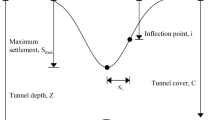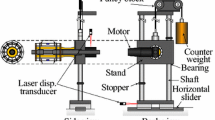Abstract
Tunnelling through soils results in ground loss, causing surface settlements and transverse movements. Where the tunnel drive passes below an existing structure, it is important to estimate the effects upon the structure. However, the free ground deformations should not simply be imposed upon a structure, because the structure contributes to stiffening of the ground. A computational soil-structure interaction analysis is required, to otain detailed stress–deformation response. First, linear finite element and Lagrangian finite difference methods are used to estimate ground movements due to a tunnel in free ground, and the results are compared with values based on empirical equations. The two linear methods and an additional hybrid FE method are then used to assess with soil-structure interaction; two cases of a typical short wall and a long wall lying across the route of tunnels of different depths. The results support the validity of the hybrid method which is used to estimate interactive ground settlements for comparison with a reported case of tunnelling below a building in central London. A more detailed case study is then undertaken to assess building damage caused by gross settlements during tunnelling in mixed soils, at a site in Workington, west Cumbria. A survey allowed estimation of free ground movements. Analysis by the hybrid method on the soils plus uncracked structures indicated intolerable horizontal stresses. Re-analysis with major cracks introduced into the structures resulted in close agreement between measured and computed settlements.
Similar content being viewed by others
References
Addenbrooke, T. (1996) Numerical analysis of tunnelling in stiff clay. Ph.D Thesis, Imperial College of Science, Technology and Medicine, London.
Attewell, P.B. (1978) Ground movements caused by tunnelling in soil. In Large ground movements and structures, J.D. Geddes (ed.), Pentech Press, London, pp. 812-948.
Attewell, P.B., Yeates, J. and Selby, A.R. (1986) Soil movements induced by tunnelling and their effects on pipelines and structures. Blackie, Glasgow.
Burland, J.B. and Wroth, C.P. (1975) Settlement of buildings and associated damage. Building Research Establishment CP33/75, Garston.
Cording, E.H., Hansmire, W.H., MacPherson, H.H., Lenzini, P.A. and Vonderohe, A.D. (1976) Displacements around tunnels in soil. Final report, Contract DOT FR 30022 Dept. of Transportation, Washington, DC.
FLAC© Fast Lagrangian Analysis of Continua. Itasca, Minneapolis, USA.
Hendry, A.W. (1981) Structural Brickwork. Macmillan, London.
Frischmann, W.W., Hellings, J.E., Gittoes, G. and Snowdon, C. (1994) Protection of the Mansion House against damage caused by ground movements due to the Docklands Light Railway extension. Proc. Inst. Civ. Engrs., Geotech. Engg. 107, 65-76.
Lee, K.M. and Rowe, R.K. (1989) Deformations caused by surface loading and tunnelling: the role of elastic anisotropy. Geotechnique 39, 125-140.
Malato, P., Torrado da Silva, J., Marques, F. and Almeida e Sousa (1998) Lisbon Metro — Behaviour of a shallow tunnel in stiff clays. World Tunnel Congress '98 Sao-Paulo, Brazil.
Morton, J. (1986) Designing for movement in brickwork. Brick Development Association Design note 10 Brick Development Association, Windsor, Berks.
New, B.M. and Bowers, K.H. (1994) Ground movement model validation at the Heathrow Express trial tunnel. Tunnelling 94, I.M.M. & Br. Tunnelling Soc. Chapman & Hall, London.
Oliver, A. (1994) Tunnel collapse followed midnight repairs. New Civil Engineer, 10th Nov.
O'Reilly, M.P. and New, B.M. (1982) Settlements above tunnels in the United Kingdom — their magnitude and prediction. Proc. Conf. Tunnelling '82, Jones, M.P. (ed.), IMM. 137-181.
PAFEC© Program for Automatic Finite Element Calculations. Pafec Ltd, Nottingham.
Potts, D.M. and Addenbrook, T.I. (1997) A structure's influence on tunnelling-induced ground movements. Proc. Inst Civ.Engrs, Geotech.Eng. 125, 109-125.
Rankin, W.J. (1987) Ground movements resulting from urban tunnelling: predictions and effects. Engineering geology of underground movements, Bell, F.G., Culshaw, M.G. Cripps, J.C and Lovell, M.A. (eds), Geol. Soc. Sp. Pub. No. 5. 79-92.
Selby, A.R. (1985) Tolerance of highway bridges to ground movements induced by tunnelling in soil. Ground Movements and Structures, Geddes, J.D. (ed.), Pentech Press, London, pp. 630-642.
Selby, A.R. (1987) Some variables in the calculation of the effects upon floor slabs of tunnelling-induced settlements. Proc. Int. Conf. on Foundations & Tunnels. ETP. pp. 15-19.
Author information
Authors and Affiliations
Rights and permissions
About this article
Cite this article
Selby, A. Tunnelling in soils – ground movements, and damage to buildings in Workington, UK. Geotechnical and Geological Engineering 17, 351–371 (1999). https://doi.org/10.1023/A:1008985814841
Issue Date:
DOI: https://doi.org/10.1023/A:1008985814841




